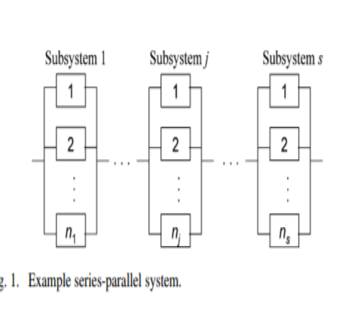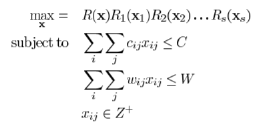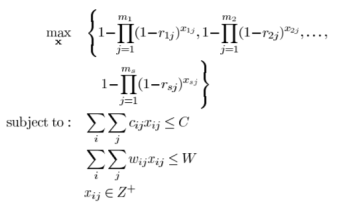Redundancy Allocation using Multiple Weighted Objectives
Redundancy Allocation using multiple weighted objectives heuristic
Abstract
A new method for optimization of system reliability was put forward and tested. In this method, the main aim is to maximize the individual system reliability. The product of individual system reliability multiples to the reliability of the entire system. Hence the multiple weighted objective heuristic involves breaking down of the problem into multiple objectives and in turn into different single objective problem. Then this sequence is done by solving the linear programing formulation. The results obtained are efficient solutions which depends on the readily available tools. Thus, on the whole this new method is more efficient when compared to the already available practices for both efficiency and performance.
- INTRODUCTION of Articles
The main aim of this journal is to design an optimal solution to maximize the system reliability. It involves solving a challenging nonlinear programming that is widely studied and applied.
 A new multiple weighted objective method was introduced by converting the problem into different individual objective to maximize each subsystem reliability for a series and parallel system. The problem is further converted to a sequential standard linear programming algorithms in a updated process. It is easily adapted process as it easily accepts problems with a mix of components with a high-performance level. Various mathematical programming and other optimization methods where solved using redundancy allocation. The redundancy allocation was solved by constraining the problem to only one type of component of the subsystem using dynamic programming. Surrogate approach is a efficient way to accommodate multiple constraints with dynamic programming. Mathematical programming approaches restricts by allowing one component choice for each subsystem.
 In the example shown in the figure below shows a series parallel system. For each subsystem, there are multiple, functional equivalent components available for used. The design involves single component selection for each subsystem or multiple components selected in parallel. The decision variables for redundancy allocation are choice of components and level of redundancy. The MWO involves converting single objective into multiple sub objectives. The next step is to combine multiple objectives into single objective into single objectives using objective weights. Different optimization was implemented with integer programming and using max-min concept to obtain an optimal pareto solution.

Nomenclature
Xij – number of components of type j used in subsystem i
R(x)- System reliability
Ri(xi)- reliability of subsystem i
Wi– objective weight assigned to the ith subsystem
Rimin- minimum subsystem reliability for subsystem i
- Explanation of the work presented in journal articles
The objective of the problem is to maximize the system reliability R(x), given the constraints of the system which is mainly a series-parallel system. There are mi functionally equivalent components available with different reliability, cost and weight for each subsystem. There are two general solution strategies for multiple objective problem. The first strategy is to obtain a composite function by combining the multiple objective functions. The second strategy is by obtaining a pareto-optimal set which is not a very effective method for the series-parallel configuration system, as there would be only possible optimal solution for one subsystem with very high reliability and other with very low reliability. The solution may have a feasible optimal outcome technically but practically it is a very poor solution for the series-parallel configuration.
The formulation consists of several distinctive features that is presented. First is by transformation method to obtain an equivalent linear formulation for the redundancy allocation problem by using standard integer formulation tools and features. The second is that this formulation allows mixing the part components as a linearized formulation and hence not limiting the solution space.
A sequence of Algebraic operations is used to convert multiple objective problem into equivalent subsystem problem. Numerical weights are combined to result in multiple objectives. All objectives are equally important and are assigned with equal weights as failure is caused due to failure of any independent system. A initial system design solution is derived by obtaining the solution for the problem. There are several possible possibilities to create a new problem. There are two alternatives, one is to increase iteratively and systematically the objective weights. And the other is to iteratively add constraints and reduce the minimum subsystem reliability. The original problem formulation, and the surrogate multiple objective formulation, are presented below as Problems P1 & P2.
Problem 1:

Problem 2 :

Problem P3 is a nonlinear integer programming that is difficult to solve. An equivalent linear programming is formulated through a series of objective transformation. An equivalent objective function has the same optimal solution.

- Discussion of Contributions
The MWO heuristic depends on an other or surrogate detailing. For the surrogate issue, the goal is to maximize the reliability of every subsystem exclusively to form a multiple objective optimization. It is coherent that, if the dependability of every subsystem is increased, then the entire system reliability will likewise be high. By taking different problem and different general solution to combine various individual solution into a combined single objective solution for the system. The author considers different distinct characteristics and cases for formulating a linear programming for redundancy allocation. He undertakes two different strategies, first being transforming the standard integer programming tools and software. The second he combines parts for linear formulation and not restricting the solution space. He formulated an equivalent linear program that is obtained series of objective transformation for a non-linear integer programming which is usually difficult to solve. An similar constant value is subtracted by which the optimal solution is not changed. Maximization problem is converted to minimization problem. The solution that maximizes the system reliability also maximizes the subsystem reliability.
- Discussion of Dificiency and Potential Improvements
The parameter that limits the process in this method is the solution time. Small problems that are less than five subsystems can be solved by integer programming formulation for many combinational problem, but for large problems that are greater than ten subsystems it is theoretically impossible to solve. In this process, most instances were solved in under 15 seconds. If by taking in account the size of the problem obtained from the CPU is very promising.
.
- Summary
The multiple heuristic depends on the original problem into a multiple objective problem. The solution for this optimization problem can be determined by this method in an effective way. Many examples were tested using this method and the results that were obtained was good. It can give a fast check of feasibility for nonlinear problem formulations and for more difficult problem. It has simplicity and ease of implementation; the heuristic was proved to be a good process to solve the redundancy allocation problem. The concern about the applicability of the MWO2 heuristic was solution time.
Acknowledgments
The authors are grateful to Willem van Jaarsveld and Rommert Dekker of Econometric institute, Erasmus University Rotterdam and Shunichi SHIMIZU and Shouji SAKURAI of Isago Engineering Centre, Toshiba Corp. inspired to do a case study upon the following topic. We thank them for the opportunity to perform this research.
References
David W. Coit and Abdullah Konak Multiple Weighted Objectives Heuristic for the Redundancy Allocation Problem ieee transactions on reliability, vol. 55, no. 3, september 2006.
W. Kuo, V. Prasad, F. Tillman, and C. L. Hwang, Optimal Reliability Design: Fundamentals and Applications. Cambridge, UK: Cambridge University Press, 2000.
D. W. Coit and A. E. Smith, “Reliability optimization for series-parallel systems using a genetic algorithm,” IEEE Transactions on Reliability, vol. 45, no. 2, pp. 254-260, June 1996.
Â
Probability of Failure
|
Probability of Failure Mode |
Possible Failure Rate |
Probability |
Ranking |
|
Very High : Failure is almost inevitable |
≥ 1 in 2 |
.50 ≤ p ≤ 1.00 |
10 |
|
Very High |
≥ 1 in 3 |
.33 ≤ p < .50 |
9 |
|
High : repeated Failure |
≥ 1 in 8 |
.125 ≤ p < .33 |
8 |
|
High |
≥ 1 in 20 |
.05 ≤ p <.125 |
7 |
|
Moderate : Occasional Failures |
≥ 1 in 80 |
.0125 ≤ p < .05 |
6 |
|
Moderate |
≥ 1 in 400 |
.0025 ≤ p < 0.0125 |
5 |
|
Moderate : Infrequent Failure |
≥ 1 in 2000 |
.0005 ≤ p .0025 |
4 |
|
Low : Relatively Few Failure |
≥ 1 in 15,000 |
.0000667 ≤ p < .0005 |
3 |
|
Low |
≥ 1 in 150,000 |
6.7 x 10^-6 ≤ p < 6.67 x 10^-5 |
2 |
|
Remote : failure is Unlikely |
≥ 1 in 1,500,000 |
6.7 x 10^-7 ≤ p < 6.67 x 10^-6 |
1 |
Likelihood of Detection
|
Detection |
Criteria |
Ranking |
|
Almost Impossible |
No known way detect failure mode |
10 |
|
Very Remote |
Very unlikely to detect failure mode |
9 |
|
Remote |
Unlikely to detect failure mode |
8 |
|
Very low |
Very low chance to detect failure mode |
7 |
|
Low |
Low Chance to detect failure mode |
6 |
|
Moderate |
Moderate chance to detect failure mode |
5 |
|
Moderately High |
Moderately high chance to detect failure mode |
4 |
|
High |
Likely to detect failure mode |
3 |
|
Very High |
Very likely to detect failure mode |
2 |
|
Almost Certain |
Will almost certainly detect failure mode |
1 |
Severity Rating
|
Severity |
Criteria |
Ranking |
|
Hazardous-without Warning |
May endanger operator; noncompliance with regulations; affects the safe use of the product; failure will occur without warning |
10 |
|
Hazardous-with Warning |
May endanger operator, noncompliance with regulations; affects the safe use of the product; failure will occur with warning. |
9 |
|
Very High |
Process or product inoperable with loss of primary function; major disruption to the production line; product may have to be scrapped; customer very dissatisfied |
8 |
|
High |
Process or product operable but at reduced level of performance; minor disruption to production line; the product may have to be sorted and a proportion ( less that 100%) scrapped; customer dissatisfied |
7 |
|
Moderate |
Process or product operable but comfort or convenience items inoperable; minor disruption to production line; a portion (less than 100%) of the product may have to be scrapped (no sorting); customer experience discomfort |
6 |
|
Low |
Process or product operable but comfort or convenience at reduced level of performance ; minor disruption to production line; a 100% of the product may have to be reworked; customer experience some dissatisfaction |
5 |
|
Very Low |
Minor disruption to production line; product may have to be sorted and a portion ( less that 100% ) reworked; cosmetic (fit and finish) defect (nonconformance ) noticed by most customer |
4 |
|
Minor |
Minor disruption to production line; a portion of the product may have to be ( less than 100%) reworked on-line but out of station cosmetic (fit and finish) defect (nonconformance) noticed by average customer |
3 |
|
Very Minor |
Minor disruption to production line; a portion of the product may have to be (less that 100%) reworked on-line but in-station; cosmetic (fit and finish) defect (nonconformance) noticed by discrimination customers |
2 |
|
None |
No Effect |
1 |
Failure Analysis
The motive of RCM is not to prevent the failure but to preserve the functions. Initially the focus was mainly on preventing failure of every maintenance schedule. But the products became more complex and maintenance cost increase in absolute terms as well as percentage of the product’s total life cycle cost. Soon it was clear the preventing the failure was technically and economically impractical. Instead, they came up with the solution of preserving the function of the system which lead to the development of RCM technique.
Failure
Identifying the functions and their function failure is an important step in RCM. Study about the failure mode identification will also have a greater impact on the system reliability. Some of the Type of Failures are
- Function Failure
When the system fails to perform to do its intended function then it’s referred as Functional Failure. The mission and motive of the system will be directly be affected when the function fails. To understand about the functional failure a deep study has to been carried out on the required function.
- Evident failure
When the failure is evident or is been made to evident to the operator, the failure is said to be an evident failure. Later, Display, dial or gauges, audible or alarms or other forms of instrument alert the operator to the failure.
- Hidden Failure
A hidden failure is a functional failure of an item that has occurred, which has not made any impact to the system, and also not evident to the operator, but which can cause a function failure to the end system. Because of the redundancy nature of the system, the system will not fail for the single point of failure. The system will lose its function on a multiple failures.
